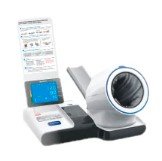Technology in Chronic Disease Management: Innovations in Hospitals for Improved Patient Outcomes
Summary
- Technology plays a crucial role in chronic disease management in hospitals.
- In the United States, medical labs and phlebotomy services rely on technology for accurate diagnosis and treatment.
- Through the use of innovative technologies, hospitals can improve patient outcomes and streamline healthcare processes.
Introduction
Chronic diseases are a leading cause of death and disability in the United States, with conditions such as diabetes, heart disease, and cancer affecting millions of Americans. Managing chronic diseases requires a multi-faceted approach that includes regular monitoring, medication management, lifestyle adjustments, and ongoing support from Healthcare Providers. Technology has revolutionized the way hospitals manage chronic diseases, allowing for more efficient and effective care for patients. In this article, we will explore how technology aids in chronic disease management in hospitals, with a focus on medical labs and phlebotomy services.
Importance of Technology in Medical Labs
Medical laboratories play a critical role in diagnosing and monitoring chronic diseases. From analyzing blood samples for glucose levels in diabetic patients to detecting tumor markers in cancer patients, medical lab technicians rely on advanced technologies to provide accurate and timely results. Some of the key technologies used in medical labs include:
- Automated analyzers: These machines can process large volumes of samples quickly and accurately, reducing the turnaround time for Test Results.
- Molecular diagnostics: Techniques such as polymerase chain reaction (PCR) and next-generation sequencing allow for the detection of genetic mutations and infectious agents.
- Robotics: Robotic systems can perform repetitive tasks with precision, freeing up lab technicians to focus on more complex analyses.
The Role of Phlebotomy in Chronic Disease Management
Phlebotomy is the practice of drawing blood from patients for diagnostic testing or blood donation. This procedure is essential in the diagnosis and monitoring of chronic diseases, as many tests rely on blood samples for accurate results. Technological advancements have made phlebotomy safer, more efficient, and less painful for patients. Some of the technologies used in phlebotomy include:
- Vacutainer systems: These devices use vacuum pressure to collect blood samples, reducing the risk of hemolysis and contamination.
- Vein-finding devices: Near-infrared technology can help phlebotomists locate veins more easily, especially in patients with difficult venous access.
- Electronic medical records: Phlebotomists can now access patient information electronically, reducing the risk of errors and ensuring that the right tests are performed.
Benefits of Technology in Chronic Disease Management
Technology offers numerous benefits in the management of chronic diseases in hospitals. Some of the key advantages include:
- Improved accuracy: Advanced technologies in medical labs and phlebotomy services ensure reliable and precise Test Results, leading to better diagnosis and treatment of chronic diseases.
- Enhanced efficiency: Automation and robotics streamline healthcare processes, reducing turnaround times for Test Results and improving patient care.
- Enhanced patient experience: Technologies such as vein-finding devices and electronic medical records make phlebotomy more comfortable for patients and ensure that Healthcare Providers have access to up-to-date information.
Challenges in Implementing Technology in Chronic Disease Management
While technology offers many benefits in chronic disease management, there are also challenges to consider. Some of the key challenges include:
- Cost: Implementing advanced technologies in medical labs and phlebotomy services can be expensive, requiring hospitals to invest in equipment, training, and maintenance.
- Training: Healthcare Providers must be trained on how to use new technologies effectively, which can take time and resources.
- Security: Protecting patient data and ensuring the security of electronic medical records is crucial in the age of cyber threats.
Future Trends in Technology for Chronic Disease Management
As technology continues to evolve, new trends are emerging in chronic disease management. Some of the future trends to watch for include:
- Telemedicine: Remote monitoring and virtual consultations allow patients with chronic diseases to receive care from the comfort of their homes.
- Artificial Intelligence: AI algorithms can analyze large datasets to predict disease progression and recommend personalized treatment plans.
- Wearable devices: Devices such as smartwatches and fitness trackers can monitor vital signs and send real-time data to Healthcare Providers for timely intervention.
Conclusion
Technology plays a crucial role in chronic disease management in hospitals, especially in medical labs and phlebotomy services. By leveraging innovative technologies, hospitals can improve patient outcomes, enhance efficiency, and provide a better overall experience for patients. As technology continues to advance, the future of chronic disease management looks promising, with new trends and opportunities on the horizon.

Disclaimer: The content provided on this blog is for informational purposes only, reflecting the personal opinions and insights of the author(s) on the topics. The information provided should not be used for diagnosing or treating a health problem or disease, and those seeking personal medical advice should consult with a licensed physician. Always seek the advice of your doctor or other qualified health provider regarding a medical condition. Never disregard professional medical advice or delay in seeking it because of something you have read on this website. If you think you may have a medical emergency, call 911 or go to the nearest emergency room immediately. No physician-patient relationship is created by this web site or its use. No contributors to this web site make any representations, express or implied, with respect to the information provided herein or to its use. While we strive to share accurate and up-to-date information, we cannot guarantee the completeness, reliability, or accuracy of the content. The blog may also include links to external websites and resources for the convenience of our readers. Please note that linking to other sites does not imply endorsement of their content, practices, or services by us. Readers should use their discretion and judgment while exploring any external links and resources mentioned on this blog.
